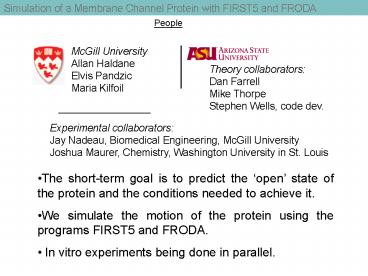Simulation of Protein motion with MSCL - PowerPoint PPT Presentation
1 / 31
Title:
Simulation of Protein motion with MSCL
Description:
Removal of Hydrophobic Tethers in transmembrane region ... tether removal. energy cutoff. embed the protein in lipid bilayer using NAMD of Schulten's group ... – PowerPoint PPT presentation
Number of Views:52
Avg rating:3.0/5.0
Title: Simulation of Protein motion with MSCL
1
People
McGill University Allan Haldane Elvis
Pandzic Maria Kilfoil
- The short-term goal is to predict the open
state of the protein and the conditions needed to
achieve it. - We simulate the motion of the protein using the
programs FIRST5 and FRODA. - In vitro experiments being done in parallel.
2
- Elvis is in the building!
3
Previous collaborative work involving Elvis..
4
- and Allan Haldane
- (may or may not be related to J.B.S. Haldane..)
5
Simulation of Protein motion with MSCL
- Outline
- Introduction
- The protein MscL
- Simulation of Statics with FIRST5
- Simulation of Dynamics with FRODA
- Results
6
(No Transcript)
7
(No Transcript)
8
Current traces for the Escherichia coli MscS and
MscL channels recorded at a pipette voltage of
40 mV and 30 mV, respectively
Martinac, B. J Cell Sci 20041172449-2460
9
Structural and functional diversity among
prokaryotic MS channels
Channel topology channel
activity activation threshold
10
Differences in two models of mechanosensitive
channel gating
- Tethered chanel (left) gated by cytoskeletal
elements - the energy input from
stimulus f x d - Lipid-bilayer channel gated by the tension in
the lipid-bilayer - the energy input is
(tension modulus) (area of extension)
11
Side view cross sections of space-filled models
of TbMscL
Model
12
The Mechanosensitive Channel Protein of Large
Conductance (MSCL)
- Mechanically Activated by tension from the
membrane - Does not exhibit any selectivity for ions
- Thought to help reduce dangerous osmotic pressure
across the cell membrane
Extracellular medium
Tension
Cell Membrane
Cytoplasm
13
The Mechanosensitive Channel Protein of Large
Conductance (MSCL)
Closed State
Extracellular View
Side View
14
Results Statics with FIRST5
Developed by Don Jacobs and Michael Thorpe
- We have the structure, now what?
- We analyze the large-scale characteristics of the
protein using FIRST5, giving a simpler model.
(Floppy Inclusions and Rigid Substructure
Topography) - Jacobs, Thorpe et al. Proteins 44,
150-165, (2001) - Decomposes the protein structure into rigid units
- Resulting simulations are much faster than
Molecular Dynamics simulations represent a
series of quasi-static steps. - Wells, Thorpe et al. Physical Biology
2, S127-S136 (2005)
15
Statics Finding the rigid units and Flexible
Regions with FIRST5
- To analyze rigidity, must first calculate the
covalent bonds, hydrogen bonds, and hydrophobic
interactions . - Addition of missing Hydrogen atoms
- Removal of Hydrophobic Tethers in transmembrane
region - Hydrogen Bond Energy cutoff for rigidity
analysis
Hydrophobic Tethers
Hydrogen Bonds
E -1.15 kcal/mol 1943 rigid clusters
E -0.84 kcal/mol 1847 Rigid clusters
Kept
Removed
Kept
16
Dynamics Pure Diffusion with FRODA
FRODA Simulates thermal motion of the rigid
units (Framework Rigidity Optimized Dynamics
Algorithm) Using the rigid units calculated by
FIRST5, FRODA calculates the possible
configurations of the structure by repeatedly
displacing all of the atoms in a random
direction, subject to the bond constraints.
17
Driven Dynamics Opening the Channel
- Must simulate the tension from the cell membrane
- Where to apply the force?
All of Transmembrane
Z regions in Transmembrane
Schulten et al, BJ (2003)
18
Results Driven Dynamics
Pulling by double Z range, E -0.84 kcal/mol
19
Results Driven Dynamics
Original
All of Transmembrane
Z regions in Transmembrane
E -0.84 kcal/mol
20
Equilibrium Dynamics
How does the protein close?
No Directed motion
Root Mean Square Displacement of All
atoms (RMSD) (Angstroms)
Outward bias
Inward bias
Conformation Number
21
Equilibrium Dynamics Pure Diffusion
Open states
Open
Outer helices
Total
RMSD (Å)
Closed
Inner helices
Cytoplasmic helices
Pure Diffusion
Conformation Number
22
Status Check
- The protein has been opened, but there are still
unexplained phenomena - There are still many options we are currently
exploring - ?hydrophobic tether removal
- ?energy cutoff
- ? embed the protein in lipid bilayer using NAMD
of Schultens group
23
Checking hydrophobic tethers in trans-membrane
region
Top (periplasmic) view
Side view
24
New hydrophobic tethers to keep
25
- Experimental approach, and further modeling
26
Goal is to conduct simultaneous FRET
(fluorescence resonance energy transfer) and
conductance measurements to monitor the opening
of the channel under controlled membrane tension
Strategies develop protein with fluorescent
labels develop system in which the protein will
be expressed prepare for electrophysiology
measurements and control of membrane tension
27
1
28
(No Transcript)
29
(No Transcript)
30
(No Transcript)
31
Strategy for Modeling these structures
32
(No Transcript)































